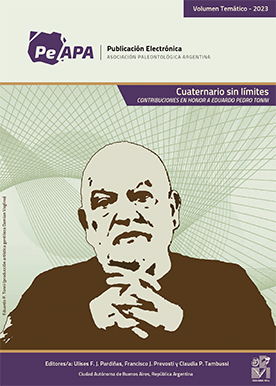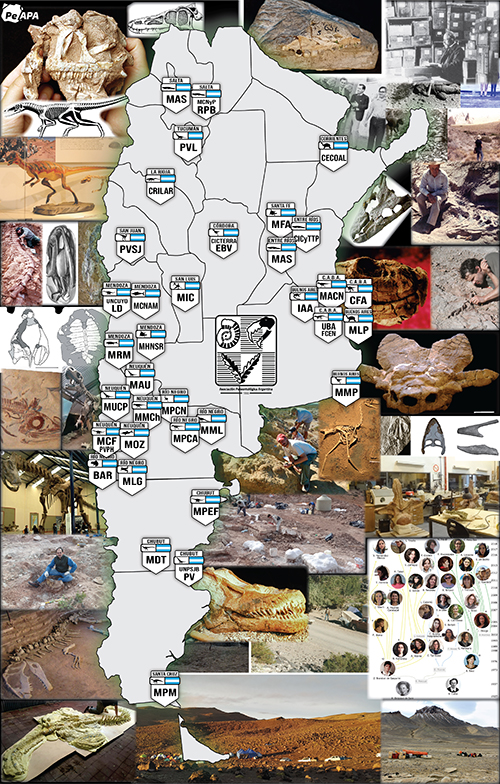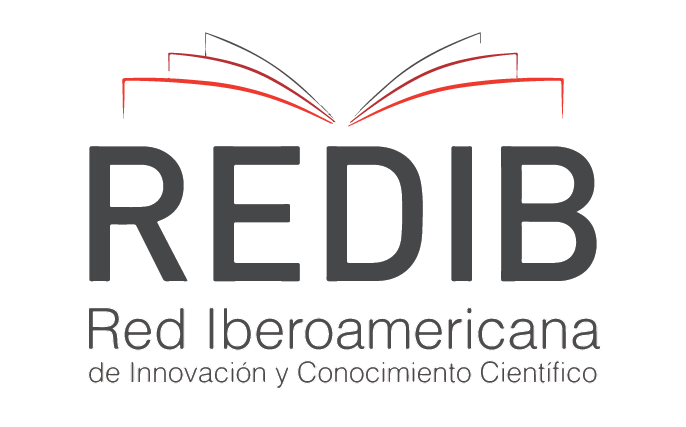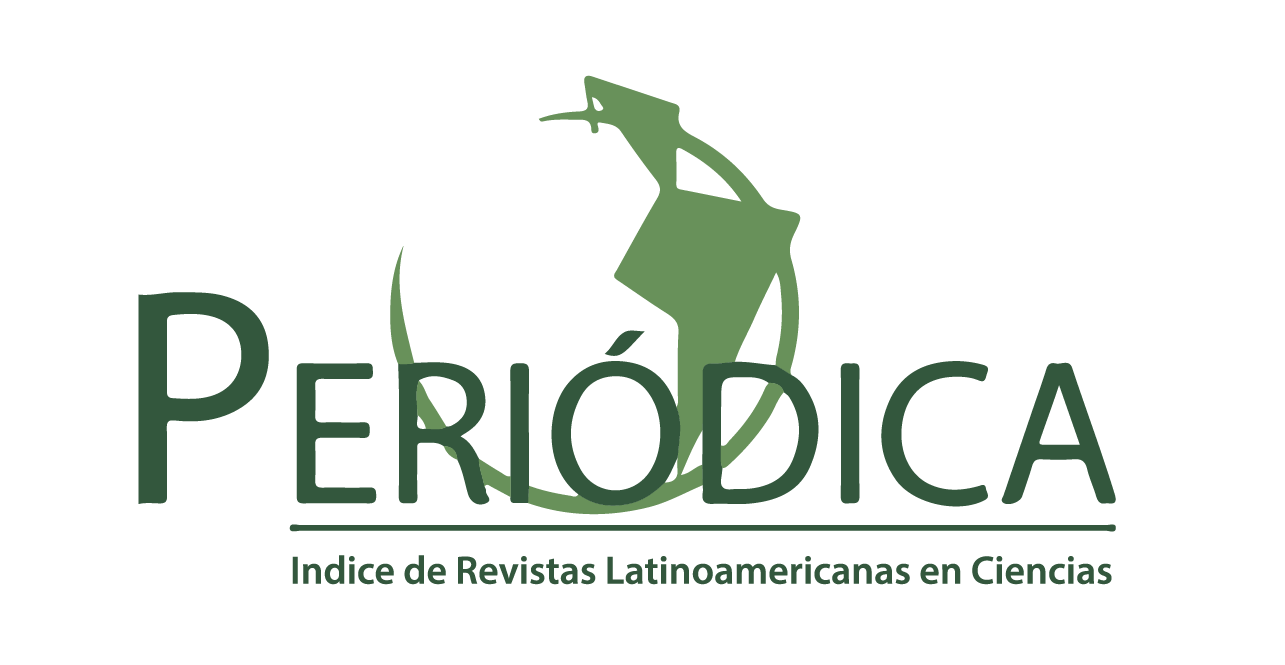DIVERSIDAD DE LOS ÉQUIDOS FÓSILES DE AMÉRICA DEL SUR
DOI:
https://doi.org/10.5710/PEAPA.06.06.2022.415Palabras clave:
Perissodactyla, Equidae, Plioceno, Pleistoceno, América del SurResumen
Las comunidades de mamíferos contemporáneas de América del Sur estuvieron definidas por el surgimiento del Istmo de Panamá y por las profundas oscilaciones climáticas durante el Pleistoceno. Los caballos son un grupo conspicuo de mamíferos inmigrantes norteamericanos que llegaron a Sudamérica durante el Plioceno tardío y no sobrevivieron a la gran extinción de la megafauna hace aproximadamente doce mil años. El presente estudio recopila datos actualizados sobre la filogenia, sistemática y ecología de este grupo en América del Sur. El primer linaje está representado por el género Equus, que aparece en el Pleistoceno medio y presenta rasgos anatómicos parecidos a los de un caballo actual. El segundo linaje son las especies incluidas en el género Hippidion, que eran caballos con características anatómicas muy distintivas que se registraron por primera vez a finales del Plioceno. Ambos géneros de caballos incluyen formas pequeñas (H. devillei, H. saldiasi, E. andium y E. insulatus) y grandes (E. neogeus y H. principale), que se dispersaron en América del Sur utilizando dos rutas diferentes. El posible modelo de esta dispersión indica que las formas pequeñas utilizaron el corredor de los Andes, mientras que los caballos más grandes se dispersaron por la ruta oriental y por algunas zonas costeras.
Referencias
Alberdi, M. T. (1987). La Familia Equidae, Gray, 1821 (Perissodactyla, Mammalia) en el Pleistoceno de Sudamérica. IV Congreso Latinoamericano de Paleontología, Santa Cruz de la Sierra, Bolivia, 1, 484–499.
Alberdi, M. T., Fernández, J., Menegaz, A.N. & Prado, J. L. (1986). Hippidion Owen 1869 (Mammalia, Perissodactyla) en sedimentos del Pleistoceno tardío de la localidad Barro Negro (Jujuy, Argentina). Estudios Geológicos, 42, 487–493.
Alberdi, M. T., Menegaz, A. N. & Prado, J. L. (1987). Formas terminales de Hippidion (Mammalia, Perissodactyla) de los yacimientos del Pleistoceno Tardío - Holoceno de la Patagonia (Argentina y Chile). Estudios Geológicos, 43, 107–115.
Alberdi, M. T. & Prado, J. L. (1993). Review of the genus Hippidion Owen, 1869 (Mammalia; Perissodactyla) from the Pleistocene of South America. Zoological Journal of the Linnean Society, 108, 1–22.
Alberdi, M. T. & Prado, J. L. (1998). Comments on: Pleistocene horses from Tarija, Bolivia, and validity of the genus Onohippidium (Mammalia: Equidae), by B.J. MacFadden. Journal of Vertebrate Paleontology, 18(3), 669–672.
Alberdi, M. T. & Prado, J. L. (2004). Caballos fósiles de América del Sur: Una historia de tres millones de años. Serie Monográfica INCUAPA, Olavarría, Argentina.
Alberdi, M.T., Prado, J. L. & Ortiz-Jaureguizar, E. (1995). Patterns of body size changes in fossil and living Equini (Perissodactyla). Biological Journal of the Linnean Society, 54, 349–370.
Ameghino, F. (1904) Recherches de Morphologie Phylognetique sur les molaires supèrieures des Ongulés. Anales del Museo Nacional, 3, 1–541.
Avilla, L. S., Bernardes, D. & Mothé, D. (2015). A new genus for Onohippidium galushai MacFadden & Skinner, 1979 (Mammalia, Equidae), from the late Hemphillian of North America. Journal of Vertebrate Paleontology, DOI: 10.1080/02724634.2014.925909.
Branco, W. (1883). Ueber eine Fossile Säugethier-Fauna von Punin bei Riobamba in Ecuador. II: Beschreibung der Fauna. Palaeontologische Abhandlunge, 1, 57–204.
Cantalapiedra, J. L., Prado, J. L., Hernández Fernández, M. & Alberdi, M. T. (2017). Decoupled ecomorphological evolution and diversification in Neogene-Quaternary horses. Sciences, 355, 627–630.
Carlini, A. A., Zurita, A. E. & Aguilera, O. (2008). North American Glyptodontines (Xenarthra, Mammalia) in the Upper Pleistocene of northern South America. Paläontologische Zeitschrift, 82, 125–38.
Cerling, T. E., Harris, M. J., MacFadden, B. J., Leakey, M. G., Quade, J., Eisenmann, V. & Ehleringer, J. R. (1997). Global Vegetation Change through the Miocene/Pliocene Boundary. Nature, 389, 153–158.
Cione, A. L. & Tonni, E. P. (1995a). Chronostratigraphy and "Land-Mammal Ages" in theCe nozoic of Southern South America: Principles, practices, and the "Uquian" Problem. Journal of Paleontology, 69, 135–59.
Cione, A. L. & Tonni, E. P. (1995b). Biostratigrafía y cronología del Cenozoico superior de la Región Pampeana. In: M. T. Alberdi, G. Leone & E. P. Tonni (Eds.). Evolución biológica y climática de la Región Pampeana durante los últimos 5 millones de años. Un ensayo de correlación con el Mediterráneo occidental. Monografías, Museo Nacional de Ciencias Naturales, CSIC (pp. 47–74) Madrid, España.
Darwin, Ch. (1845). Journal of Researches into the Natural History and Geology of the Countries Visited during the Voyage of H.M.S. Beagle. Round the World, under the Command of Capt. Fitz Roy, 2nd ed.; R.N. John Murray: London, UK, p. 520.
Der Sarkissian, C., Vilstrup, J. T., Schubert, M., Seguin-Orlando, A., Eme, D., Weinstock, J., Alberdi, M. T., Martin, F., Lopez, P. M., Prado, J. L., Prieto, A., Douady, C. J., Stafford, T. W., Willerslev, E. & Orlando, L. (2015). Mitochondrial genomes reveal the extinct Hippidion as an outgroup to all living equids. Biology Letters, 11, 20141058.
Edwards, E. J. & Smith, S. A. (2010). Phylogenetic analyses reveal the shady history of C4 grasses. Proceedings of the National of Academy of Sciences, USA, 107(6), 2532–2537.
Eisenmann, V. & Brunet, M. J. (1973). Présence simultanée de Cheval et d`Hipparion dans le Villafranchien Moyen de France, Roccaneyra (Puy-de-Dôre); Etude critique de cas semblables (Europe et Proche-Orient). In: International Colloques “The Boundary between Neogene and Quaternary” Collection of Papers, pp 104–122.
Froehlich, D. J. (2002). Quo vadis Eohippus? The systematics and taxonomy of the early Eocene equids (Perissodactyla). Zoological Journa of the Linnean Society, 134, 141–256.
Gould, S. J. & Eldredge, N. (1977). Puntuated equilibria: the tempo and mode of evolution reconsidered. Paleobiology, 3, 115–151.
Graham RW (1999) Late Cretaceous and Cenozoic History of North American Vegetation. Oxford University Press, New York.
Hoffstetter, R. (1950). Algunas observaciones sobre los caballos fósiles de la América del Sur. Amerhippus gen. nov. Boletín de informaciones Científicas Nacionales, 3, 426–454.
Hoffstetter, R. (1952). Les mammifères Pléistocènes de la République de l’Equateur. Mémoires de la Société Géologique de France, 66, 1–391.
Hulbert, R. C. Jr. (1993). Late Miocene “Nannippus” (Mammalia: Perissodactyla) from Florida, with a description of the smallest Hipparionine Horse. Journal of Vertebrate Paleontology, 13, 350–366.
Hulbert, R. C. Jr. & MacFadden, B. J. (1991). Morphological transformation and cladogenesis at the base of the adaptive radiation of Miocene hypsodont horses. American Museum Novitates, 3000, 1-61.
Hylander, W. L. (1985). Mandibular function and biomechanical stress and scaling. American Zoologist, 25, 315-330.
Janis, C. M. (1988). An estimation of tooth volume and hypsodonty indices in ungulate mammals and the correlation of these factors with dietary preferences. In: D. E. Russel, J. P. Santorio & D. Signogneu-Russel (Eds). Teeth Revisited, Proceedings of the VII international symposium on dental morphology. Museum National d’Histoire Naturelle, Memoires, 53, 367–387.
Janis, C. M. (1989). A climatic explanation for patterns of evolutionary diversity in ungulate mammals. Palaeontology, 32, 463–481.
Janis, C. M. (1990). Correlation of cranial and dental variables with body size in ungulates and macropodids. In: J. Damuth & B. J. MacFadden (Eds.). Body Size in Mammalian Paleobiology: Estimation and Biological Implications. Cambridge University Press (pp. 255-299), Cambridge.
Janis, C. M. (1993). Tertiary Mammal evolution in the context of changing climates, vegetation, and tectonic events. Annual Review Ecology Systematic, 24, 467–500.
Janis, C. M. (1997). Ungulate teeth, diets, and climatic changes at the Eocene/Oligocene boundary. Zoology Anales Complex Systematic, 100, 203–220.
Janis, C. M. (1998). Introduction. In: C. M. Janis, K. M. Scott & L. L. Jacons (Eds). Evolution of tertiary mammals of North America: I. Terrestrial, Carnivores, Ungulates and Ungulatelike Mammals. (pp. 1–17), Cambridge University Press.
Janis, C. M. & Wilhelm, P. B. (1993). Were there mammalian pursuit predators in the Tertiary? Dances with wolf avatars. Journal of Mammal Evolution, 1(2), 103–125.
Janis, C. M., Damuth, J. & Theodor, J. M. (2000). Miocene ungulates and terrestrial primary productivity: where have all the browsers gone? Proceedings of the National Academy of Sciences, USA, 97, 7899–7904.
Jungers, W. L. (1988). Relative joint size and hominoid locomotor adaptations with implications for the evolution of hominid bidedalism. Journal of Human Evolution, 17, 247–265.
Linnaeus, C. (1758). Systema naturae peregna tria naturae, secundum classes, ordines, genera, species cum characteribus, differentiis, synonymis, locis. Editio decimal, reformata, Laurentii Salvii, Stockholm, p 824.
Lindsay, E. H., Opdyke, N. D. & Johnson, N. M. (1980). Pliocene dispersal of the horse Equus and late Cenozoic mammalian dispersal events. Nature, 287, 135–138.
Lund, P. W. (1840). Nouvelles Recherches sur la Faune Fossile du Brésil. Annales de Sciences Naturais, 13, 310–319.
MacFadden, B. J. (1986). Fossil horses from “Eohippus” (Hyracotherium) to “Equus”: scaling Cope’s Law, and the evolution of body size. Paleobiology, 12(4), 355-369.
MacFadden, B. J. (1992). Fossil Horses. Systematics, Paleobiology, and Evolution of the Family Equidae. Cambridge University Press, New York.
MacFadden, B. J. (1997). Pleistocene horses from Tarija, Bolivia, and validity of the genus Onohippidium (Mammalia: Equidae). Journal of Vertebrate Paleontology, 17, 199–218.
MacFadden, B. J. (2000). Middle Pleistocene Climate Change recorded in Fossil Mammal Teeth from Tarija Bolivia, and Upper limit of the Ensenadan Land-Mammal Age. Quaternary Research, 54, 121–131.
MacFadden, B. J. (2005). Diet and habitat of toxodont megaherbivores (Mammalia, Notoungulata) from the late Quaternary of South and Central America. Quaternary Research, 64, 113–124
MacFadden, B. J. (2013). Dispersal of Pleistocene Equus (Family Equidae) into South America and Calibration of GABI 3 Based on Evidence from Tarija, Bolivia. PLoS One, 8(3), e59277. doi:10.1371/journal.pone.0059277
MacFadden, B. J. & Azzaroli, A. (1987). Cranium of “Equus insulatus” (Mammalia, Equidae) from the Middle Pleistocene of Tarija, Bolivia. Journal of Vertebrate Paleontology, 7, 325–334.
MacFadden, B. J. & Shockey, B. J. (1997). Ancient feeding ecology and niche differentiation of Pleistocene mammalian herbivores from Tarija, Bolivia: morphological and isotopic evidence. Paleobiology, 23, 77–100.
MacFadden, B .J. & Skinner, M. F. (1979). Diversification and Biogeography of the One-Toed Horses Onohippidium and Hippidion. Postilla, 175, 1–10.
MacFadden, B. J. & Cerling, T. E. (1994). Fossil horses, carbon isotopes and Global change. Trends in Ecology & Evolution, 9, 481–486.
MacFadden, B. J., Siles, O., Zeitler, P., Johnson, N. M. & Campbell, K. E. (1983). Magnetic Polarity Stratigraphy of the Middle Pleistocene (Ensenaden) Tarija Formation of Southern Bolivia. Quaternary Research, 19, 172–187.
MacFadden, B. J., Cerling, T. E. & Prado, J. L. (1996). Cenozoic Terrestrial Ecosystem in Argentina Evidence from Carbon isotopes of Fossil Mammal Teeth. Palaios, 11, 319–327.
Machado, H. & Avilla, L. (2019). The diversity of south American Equus: did size really matter?. Frontiers in Ecology and Evolution, 7, 235. https://doi.org/10.3389/fevo.2019.00235
Machado, H., Grillo, O., Scott, E. & Avilla, L. (2017). Following the footsteps of the South American Equus: are autopodia taxonomically informative? Journal of Mammalia Evolution, 25, 397–405. doi: 10.1007/s10914-017-9389-6
Maguire, K. C. & Stigall, A. L. (2008). Paleobiogeography of Miocene Equinae of North America: A phylogenetic biogeographic analysis of the relative roles of climate, vicariance, and dispersal. Palaeogeography, Palaeoclimatology, Palaeoecology, 267, 175–184.
Marsh, O. C. (1874). Notice of new equine mammals from the Tertiary formation. Journal of Natural History, 13(77), 397–400.
Matthew, W. D. (1912). The new four-toed horse skeleton. American Museum Journal, 12, 186.
Matthew, W. D. (1926). The evolution of the horses: a record and its interpretation. Quaterly Review Biology, 1, 139–185.
Moreno, F. P. (1891). Onohippidium munizi. Breve historia sobre los restos fósiles de un género nuevo de la Familia de los Equidae conservados en el Museo de La Plata. Revista del Museo La Plata 2: 65–71.
Moreno, F. P. (1891). Onohippidium Munizi. Breve Historia sobre los restos fósiles de un género nuevo de la familia de los Equidae conservados en el Museo de La Plata. Revista del Museo de la Plata, 2, 65–71.
Moreno Bofarull, A., Arias Royo, A., Hernández Fernández, M., Ortiz-Jaureguizar, E. & Morales, J. (2008). Influence of continental history on the ecological specialization and macroevolutionary processes in the mammalian assemblage of South America: differences between small and large mammals. BMC Evolutionary Biology, 8, DOI:10.1186/1471-2148-8-97
Morgan, G. S. (2002). Late Rancholabrean mammals from southernmost Florida, and the Neotropical influence in Florida Pleistocene faunas. Smiths Contributions Paleobiology, 93, 15–38.
Morgan, G. S. (2005). The Great American Biotic Interchange in Florida. Bulletin Florida Museum National History, 45, 271–312.
Orlando, L., Male, D., Alberdi, M. T., Prado, J. L., Prieto, A., Cooper, A. & Hänni, C. (2008). Ancient DNA clarifies the Evolutionary History of American Late Pleistocene Equids. Journal Molecular Evolution, 66, 533–538.
Orlando, L., Metcalf, J.L., Alberdi, M.T., Telles-Antunes, M., Bonjean, D., Otte, M., Martin, F., Eisenmann, V., Mashkour, M., Morello, F., Prado, J.L., Salas-Gismondi, R., Shockey, B.J., Wrinn, P.J., Vasil’ev, S.K., Ovodov, N.D., Cherry, M.I., Hopwood, B., Male, D., Austin, J.J., Hännia, C. & A. Cooper. 2009. Revising the recent evolutionary history of equids using ancient DNA. Proceeding of the National Academie of Sciences of the USA, 106(51), 21755–21759.
Ortiz Jaureguizar, E. (1997). La fauna de Mamíferos de América del Sur y el Gran Intercambio Biótico Americano: un ejemplo de invasión natural a escala continental. In Actas I Jornadas Nacionales y Regionales Sobre Medio Ambiente, 1, 134–141.
Ortiz Jaureguizar, E. (2001). Cambios en la diversidad de los mamíferos sudamericanos durante el lapso Mioceno Superior-Holoceno: el caso pampeano. In: G. Meléndez, Z. Herrera, G. Delvene & B. Azanza B (Eds). Los Fósiles y la Paleogeografía. Publicaciones del SEPAZ, Universidad de Zaragoza, 5, 397–403.
Ortiz Jaureguizar, E. & Cladera, G. (2006). Paleoenvironmental evolution of southern South America during the Cenozoic. Journal of Arid Environment, 66, 489–532.
Osborn, H. F. (1910). The age of mammals in Europe, Asia and North America. The Macmillan Company, New York
Owen, R. 1840. The Zoology of The Voyage of H.M.S. Beagle under the command of Captain Fitzroy, R.N., during the years 1832 to 1836. Part I. Fossil Mammalia, Ed. & superv. C. Darwin, London, 112 pp.
Owen, R. 1869. On fossil teelh of equines from Central and South America, referable to Equus conversidens, Equus tau, and Equus arcidens. Proceedings of the Royal Society of London, 17, 267–268.
Pascual, R., Ortiz Jaureguizar, E. & Prado, J. L. (1996). Land Mammals: Paradigm of Cenozoic South American Geobiotic Evolution. Münchner Geowissenschaftlich Abhandlungen, Geologie Paläontologie, A30, 265–319.
Patterson, B. & Pascual, R. (1972). The fossil mammal fauna of South America. In: A. Keast, F. C. Erk & Glass (eds). Evolution, Mammals and Southern Continents, University of New York Press (pp. 247–309), Albany.
Peters, R. H. & Wassenberg, K. (1983). The effect of body size on animal abundance. Oecologia, 60, 89–96.
Prado, J. L. (1984). Fenética de los metatarsianos de taxa fósiles Hippidion Owen, Onohippidium Moreno, Parahipparion C. Ameghino y Equus (Amerhippus) Linne (Mammalia, Perissodactyla). CIPFE Orione Contribución Biología, Montevideo, 11, 11–15.
Prado, J. L. & Alberdi, M. T. (1994). A quantitative review of the horse Equus from South America. Paleontology, 37, 459–481.
Prado, J. L. & Alberdi, M. T. (1996). A cladistic analysis of the Horses of the tribe Equini. Palaeontology, 39, 663–680.
Prado, J. L. & Alberdi, M. T. (2008). Restos de Hippidion y Equus (Amerhippus) procedentes de las Barrancas de San Lorenzo, Pleistoceno tardío (provincia de Santa Fé, Argentina). Revista Española de Paleontología, 23, 225–236.
Prado, J. L. & Alberdi, M. T. (2012). Equidos y gonfoterios del Pleistoceno tardío de San Pedro, provincia de Buenos Aires, Argentina. Estudios Geológicos, 68, 261–276.
Prado, J. L. & Alberdi, M. T. (2014). Global evolution of Equidae and Gomphotheriidae from South America. Integrative Zoology, 9, 434–443.
Prado, J. L. & Alberdi, M. T. (2016). Fossil Horses from Argentina. In: F. L. Agnolin, G. L. Lio, F. Brissón Egli, N. Chimento & F. E. Novas (Eds.): Historia Evolutiva y Paleobiogeográfica de los Vertebrados de América del Sur, Contribuciones Científicas del Museo Argentino de Ciencias Naturales “Bernardino Rivadavia”, 6, 303–309.
Prado, J. L. & Alberdi, M. T. (2017). Fossil Horses of South America. Phylogeny, Systematics and Ecology. The Latin American Studies Book Series (pp. 1-150), Springer.
Prado, J. L., Alberdi, M. T. & Reguero, M. A. (1998). El registro más antiguo de Hippidion Owen, 1869 (Mammalia, Perissodactyla) en América del Sur. Estudios Geológicos, 54, 85–91.
Prado, J. L., Alberdi, M. T. & Reguero, M. A. (2000). Comentarios sobre la geocronología, estratigrafía y paleontología de vertebrados de la Fm. Uquía en el perfil de Esquina Blanca, Jujuy. Respuesta a E. P. Tonni & A. L. Cione. Estudios Geológicos, 56, 133–137.
Prado, J. L., Sánchez, B. & Alberdi, M. T. (2011). Ancient feeding ecology inferred from stable isotopic evidence from fossil horses in South America over the past 3 Ma. BMC Ecology, 11, 15. http://www.biomedcentral.com/1472-6785/11/15
Reguero, M. A., Candela, A. M. & Alonso, R. N. (2007). Biochronology and biostratigraphy of the Uquía Formation (Pliocene–early Pleistocene, NW Argentina) and its significance in the Great American Biotic Interchange. Journal of South American Earth Sciences, 23, 1–16.
Saarinen, J., Eronen, J., Fortelius, M., Seppä, H. & Lister, A. M. (2016). Patterns of diet and body mass of large ungulates from the Pleistocene of Western Europe, and their relation to vegetation. Palaeontologia Electronica, 19(3), 1–58.
Sage, R. F., Wedin, D. A. & Li, M. (1999). The biogeography of C4 photosynthesis: patterns and controlling factors. In: R. F. Sage & R. K. Monson (Eds). Plant biology, physiological ecology series. (pp 313–373), Academic Press.
Sánchez, B., Prado, J. L. & Alberdi, M. T. (2004). Feeding ecology, dispersal and extinction of South American Pleistocene gomphotheres (Gomphotheriidae, Proboscidea). Paleobiology, 30, 146–61.
Sánchez, B., Prado, J. L. & Alberdi, M. T. (2006). Ancient feeding, ecology and extinction of Pleistocene horses from the Pampean Region, Argentina. Ameghiniana, 43, 427–436.
Scillato-Yané, G. J., Carlini, A. A., Tonni, E. P. & Noriega, J. I. (2005). Palaeobiogeography of the late Pleistocene pampatheres of South America. In: J. Rabassa & A. A. Carlini (Eds). Quaternary Paleontology and Biostratigraphy of Southern South America. Journal of South American Earth Sciences, 20, 131–138.
Scott, K. M. (1990). Postcranial dimensions of ungulates as predictors of body mass. In: J. Damuth & B. J. MacFadden(Eds.). Body Size in Mammalian Paleobiology: Estimation and Biological Implications. Cambridge University Press Cambridge, 301–335.
Shoemaker, L. & Clauset, A. (2014). Body mass evolution and diversification within horses (family Equidae). Ecological letters, 17(2), 211–220.
Shotwell, J. A. (1961). Late Tertiary biogeography of horses in the northern Great Basin. Journal of Paleontology, 35(1), 203–217.
Simpson, G. G. (1951). Horses: The Story of the Horse Family in the Modern World and through Sixty Million Years of History. Oxford University Press, New York.
Simpson, G. G. (1953). Horses. The Story of the Horse Family in the Modern World and through sixty million years of History. New York. Oxford University Press, pp. 247.
Simpson, G. G. (1980). Splendid Isolation. The curious history of South American Mammals. Yale University Press, New Haven.
Stebbins, G. L. (1981). Coevolution of grasses and herbivores. Annals of the Misouri Botanical Garden, 68, 75–86.
Stigall, A. L. (2013). Analysing Links between Biogeography, Niche Stability and Speciation: The Impact of Complex feedbacks on Macroevolutionary Patterns. Palaeontology, 56, 1225–1238.
Stirton, R. A. (1947). Observations on evolutionary rates in hypsodonty. Evolution, 1, 34–41.
Vilstrup, J. T., Seguin-Orlando, A., Stiller, M., Ginolhac, A., Raghavan, M., Sandra, C. A., Nielsen, S. C. A., Weinstock, J., Froese, D., Vasiliev, S. K., Ovodov, N. D., Clary, J., Helgen, K. M., Fleischer, R. C., Cooper, A., Shapiro, B. & Orlando, L. (2013). Mitochondrial Phylogenomics of Modern and Ancient Equids. PLoSOne, 8(2), e55950. doi:10.1371/journal.pone.0055950
Vrba, E. S. (1992). Mammals as key to evolutionary theory. Journal of Mammalogy, 73, 1–28.
Vrba, E. S. (1993). Turnover-pulses, the red queen, and related topics. American Journel Science, 293A, 418–452.
Vrba, E. S. (1995). On the connections between paleoclimate and evolution. In: E. S. Vrba, G. H. Denton, T. C. Partridge & L. H. Burckle (Eds). Paleoclimate and evolution with emphasis on human origins (pp. 24–45), Yale University Press, New Haven.
Vrba, E.S. & DeGusta, D. (2004). Do species populations really start small? New perspectives from the late Neogene fossil record of African mammals. Philosophical Transations Royal Society of London, Ser. B 359, 285–293.
Wagner, A. (1860). Ueber fossile Säugetierknochen am Chimborasso. Sitzugsberichte der königlich bayerischen Akademie der Wissenschaften zu Müchen, 330-338.
Wang, Y., Cerling, T. E. & MacFadden, B. J. (1994). Fossil horses and carbon isotopes: new evidence for Cenozoic dietary, habitat, and ecosystem changes in North America. Palaeogeography, Palaeoclimatology, Palaeoecology, 107, 269–279.
Webb, S. D. (1976). Mammalian faunal dynamics of the great American interchange. Paleobiology, 2, 220-234.
Webb, S. D. (1977). A history of savanna vertebrates in the New world. Part I: North America. Annual Review of Ecology & Systematics, 8, 355-380.
Webb, S. D. (1978). A history of savanna vertebrates in the New world. Part II: South America and the Great Interchange. Annual Review of Ecology & Systematics, 9, 393–426.
Webb, S. D. (1983). The rise and fall of the late Miocene ungulate fauna in North America. In: M. H. Nitecki (Ed.). Coevolution. (pp. 267–306), The University of Chicago Press.
Webb, S. D. (1985). Late Cenozoic mammal dispersals between the Americas. In: F. G. Stehli & S. D. Webb (Eds.). The Great American Biotic Interchange. (pp. 357–386) Plenum Press, New York and London.
Webb, S. D. (1991). Ecogeography and the Great American Interchange. Paleobiology, 17, 266-280.
Webb, S. D., Hulbert, R. C. Jr. & Lambert, W. D. (1995). Climatic Implications of Large-Herbivore. Distributions in the Miocene of North America. In: E. S. Vrba, G. H. Denton, T. C. Partridge & L.H. Burckle (Eds.). Paleoclimate and Evolution with emphasis on human origins (pp. 91–108), Yale University Press, New Haven.
Weinstock, J., Willerslev, E., Sher, A., Tong, W., Ho, S. Y., Rubenstein, D., Storer, J., Burns, J., Martin, L., Bravi, C., Prieto, A., Froese, D., Scott, E., Xulong, L. & Cooper, A. (2005). Evolution, systematics, and phylogeography of pleistocene horses in the new world: a molecular perspective. PLoS Biology, 3, e241.
Woodburne, M. O., Cione, A. L. & Tonni, E. P. (2006). Central American provincialism and the Great American Biotic Interchange. In: O. Carranza-Castañeda & E. H. Lindsay (Eds). Advances in Late Tertiary Vertebrate Paleontology in Mexico and the Great American Biotic Interchange. Publicación Especial del Instituto de Geología y Centro de Geociencias de la Universidad Nacional Autónoma de México, 4, 73–101.
Woodburne, M. O. & MacFadden, B. J. (1982). A reappraisal of the systematics, biogeography and evolution of fossil horses. Paleobiology, 8(4), 315–327.
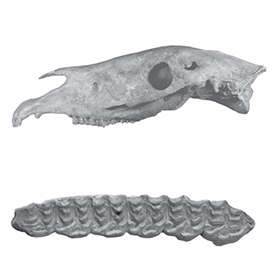
Archivos adicionales
Publicado
Número
Sección
Licencia
Derechos de autor 2023 Jose Luis Prado, María Teresa Alberdi

Esta obra está bajo una licencia internacional Creative Commons Atribución-SinDerivadas 4.0.

Los/las autores/as conservan los derechos de autor/a y garantizan a la revista el derecho de ser la primera publicación del trabajo licenciado bajo una licencia CC Attribution-NonCommercial 4.0 que permite a otros/as compartir el trabajo con el reconocimiento de la autoría y de la publicación inicial en esta revista.





